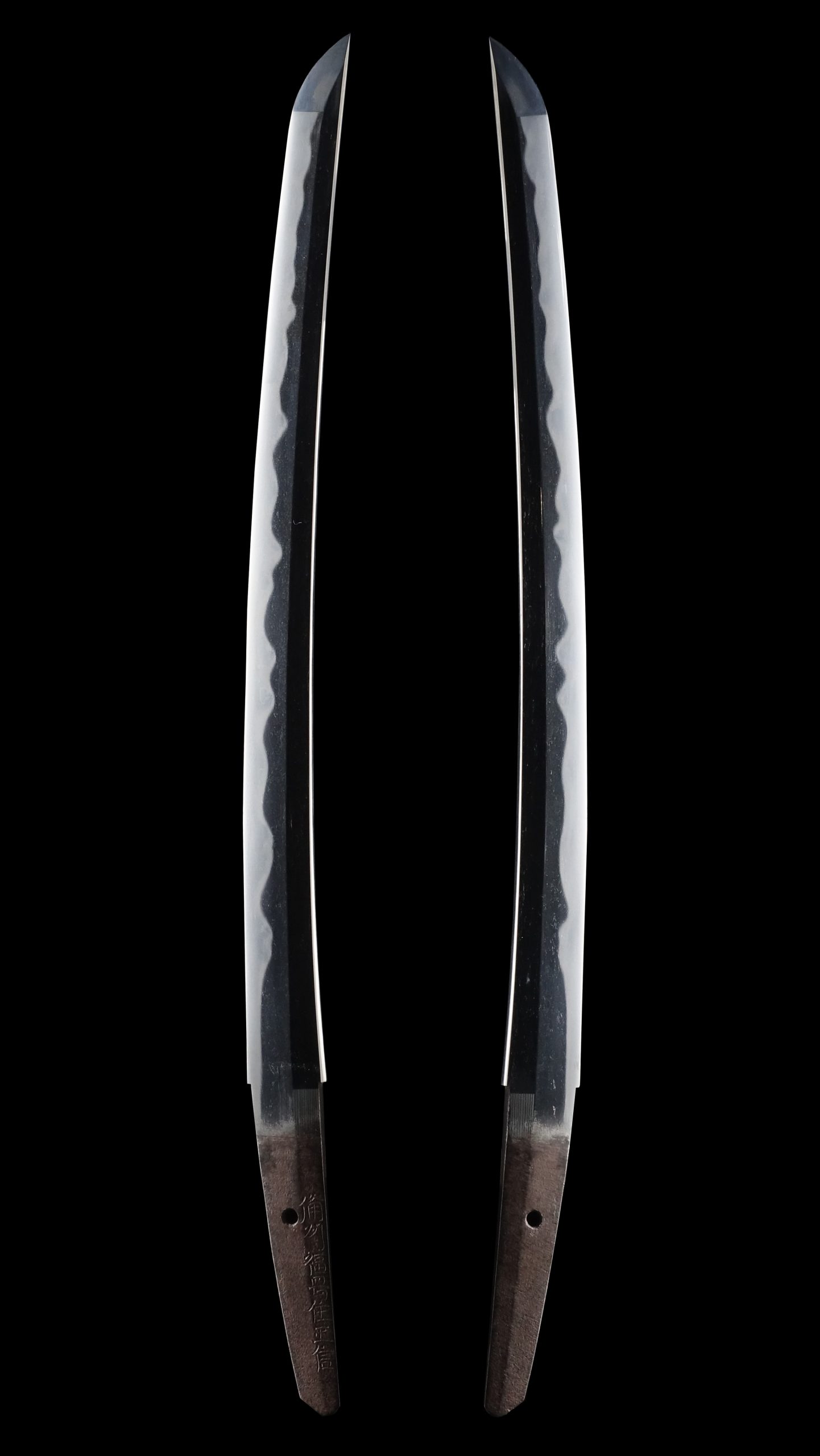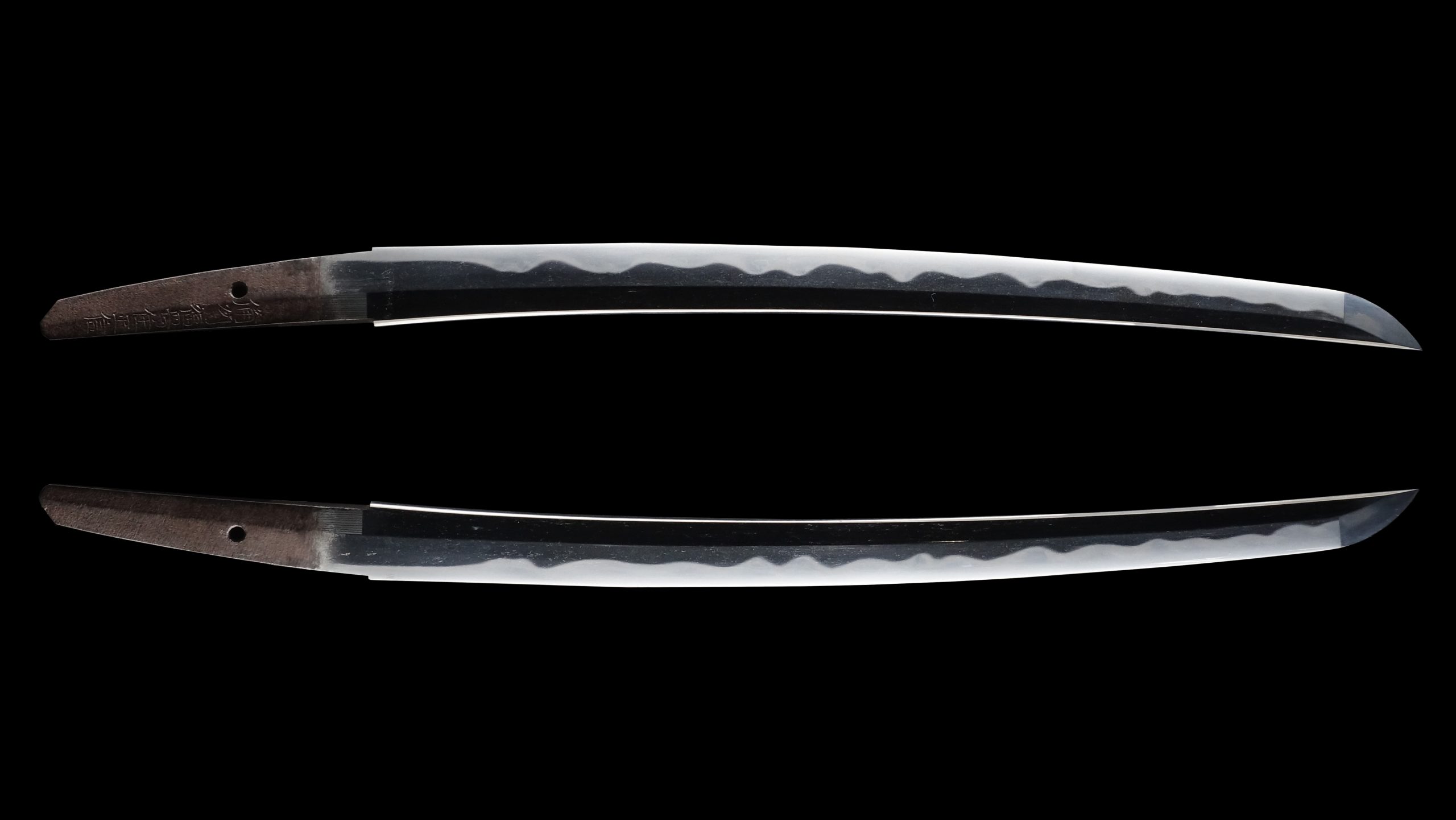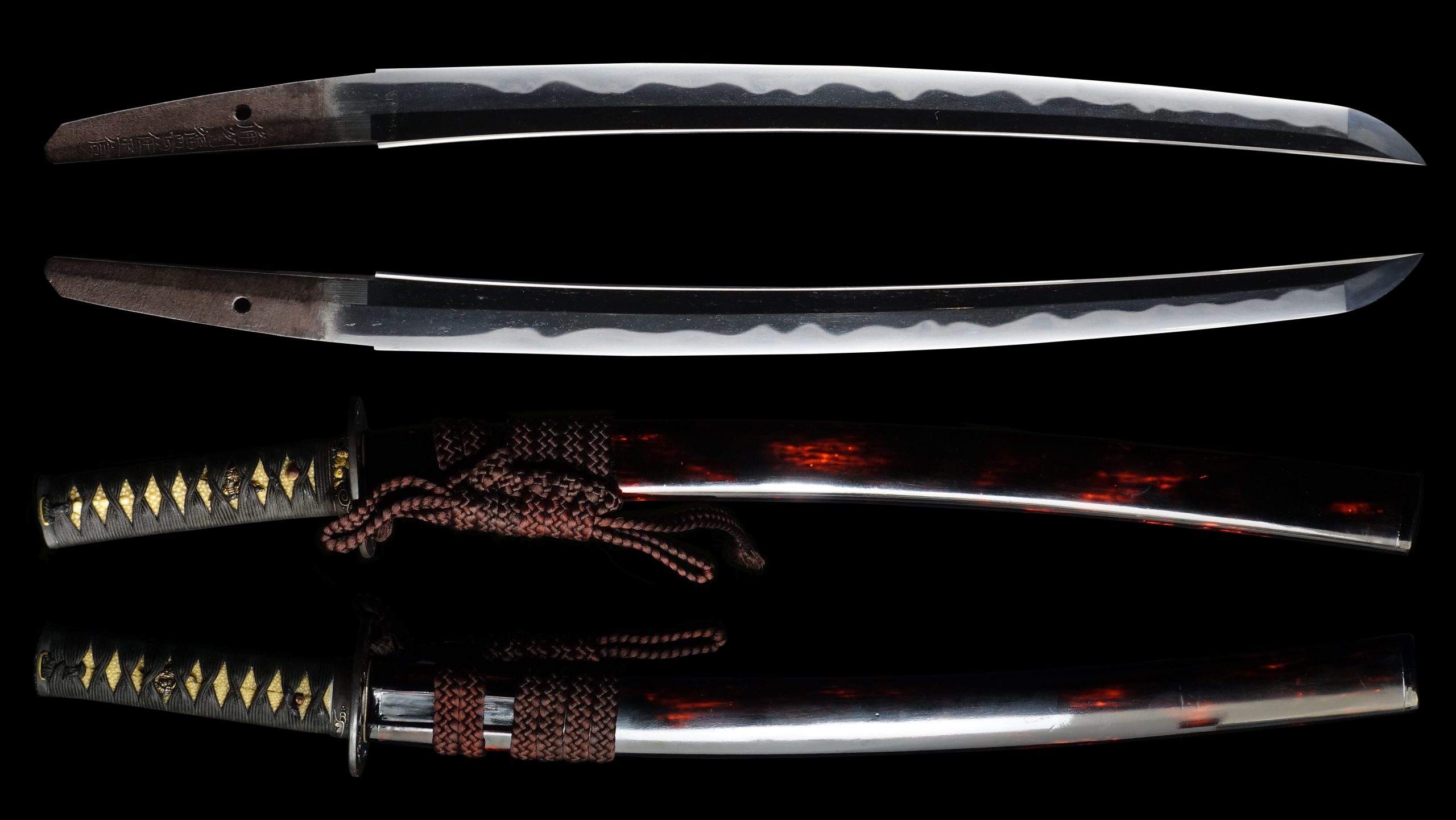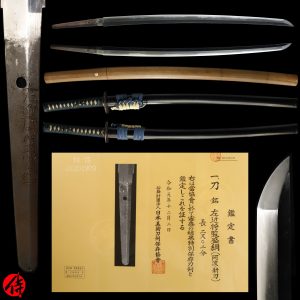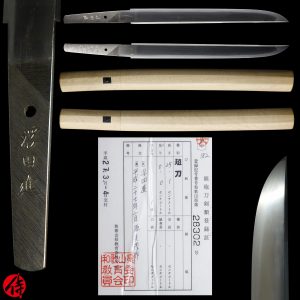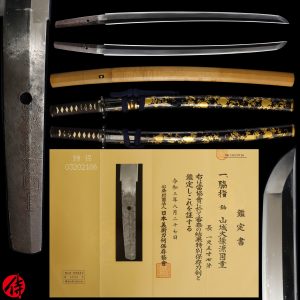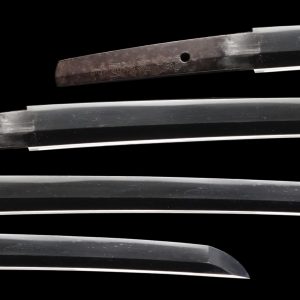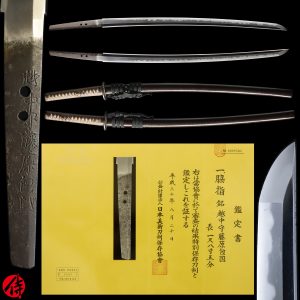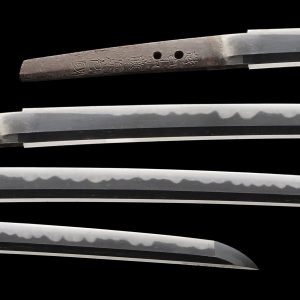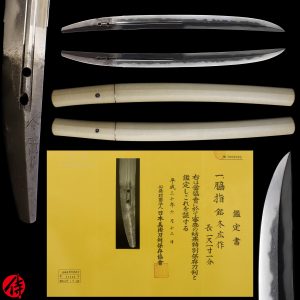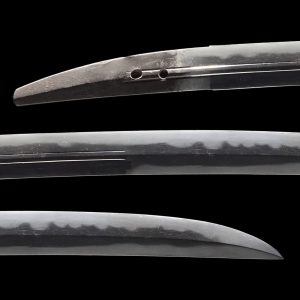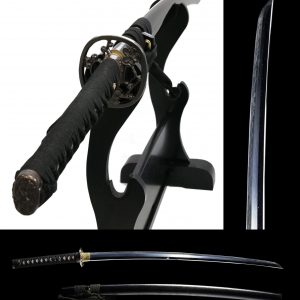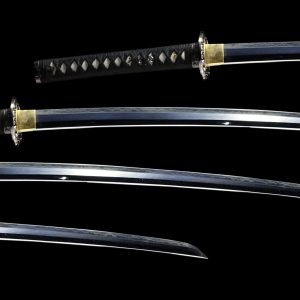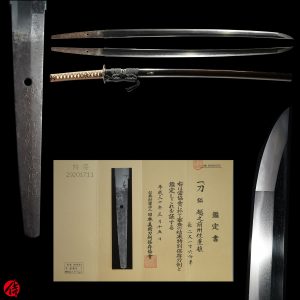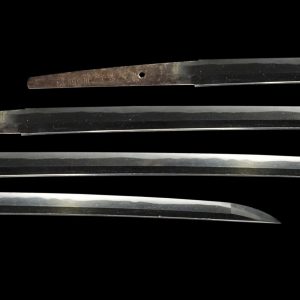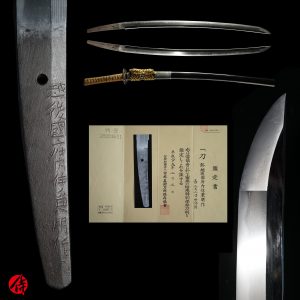Antique Japanese Sword Wakizashi Signed by Masanobu with NBTHK Kicho Certificate
【Description】
This blade was forged by Bishu Fuokuka Jyu Masanobu(備州福岡住正信) during the early Edo period according to the NBTHK’s appraisal. Bishu is the name of the province located in Today’s Okayama prefecture. Fukuoka is the name of the city famous for sword-forging from ancient times. Bishu is also known as Bizen, which created one of the five most Japanese sword-forging techniques called BIZEN DEN.
BIZEN is located near the Chugoku Mountains, where iron sands, one of the essential materials for making Japanese swords, were abundant. Furthermore, BIZEN swordsmiths had close access to Yoshi River, where they could find water and charcoal. This geological location contributed to the swordsmiths to forge high-quality refined blades. We presume BIZEN was quite active in sword-forging from ancient times. It is said that BIZEN DEN was created by groups of swordsmiths there after the late Heian era(Late 12th century ).
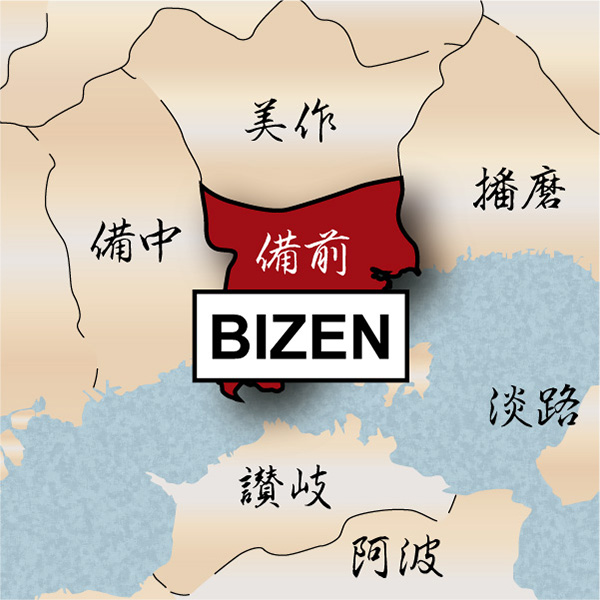
The swordsmiths in Bizen exceedingly prospered and produced many swords for feudal lords during the late Muromachi period as it was in the middle of the Sengoku period(Warring state). As a result, the demand for blades increased among strong feudal lords, and so many practically designed swords were forged and must have been used on battlefields.
When this blade was made, Japan enjoyed a relatively peaceful time called the Edo period. During the Edo period. (1603-1868 A.D.), the use of Wakizashi became more widespread among Samurais. Because the Edo Government had launched the national law to force all Samurais to wear two Japanese swords (Katana and Wakizashi) to identify themselves as the regime’s military officers.
Wakizashi refers to a 30-60 cm long blade (11.8-28.6 inches) and was worn on the waist along with Katana. Samurai carried Wakizashi as a backup sword next to Katana. Samurai needed to use Wakizashi when he fought in a small room or proximity where Katana would be too long to unsheathe. Also, when Samurai entered a castle, he had to leave his Katana to the castle guard. In contrast, Wakizashi was allowed to bring inside as self-protection.
Based on the characteristic of this blade, we believe it was forged for a high-ranked Samurai who needed an accompanying wakizashi with his Katana. Its condition is excellent and has a very distinctive Hamon tempering line.
We are confident you will cherish the beauty of this Wakizashi as well as intricate, gorgeous sword mountings.
【 Blade】
Cutting Edge Length(Nagasa): 39.2 cm (15.4 inches)
Curvature(Sori):0.8 cm(0.315 inches)

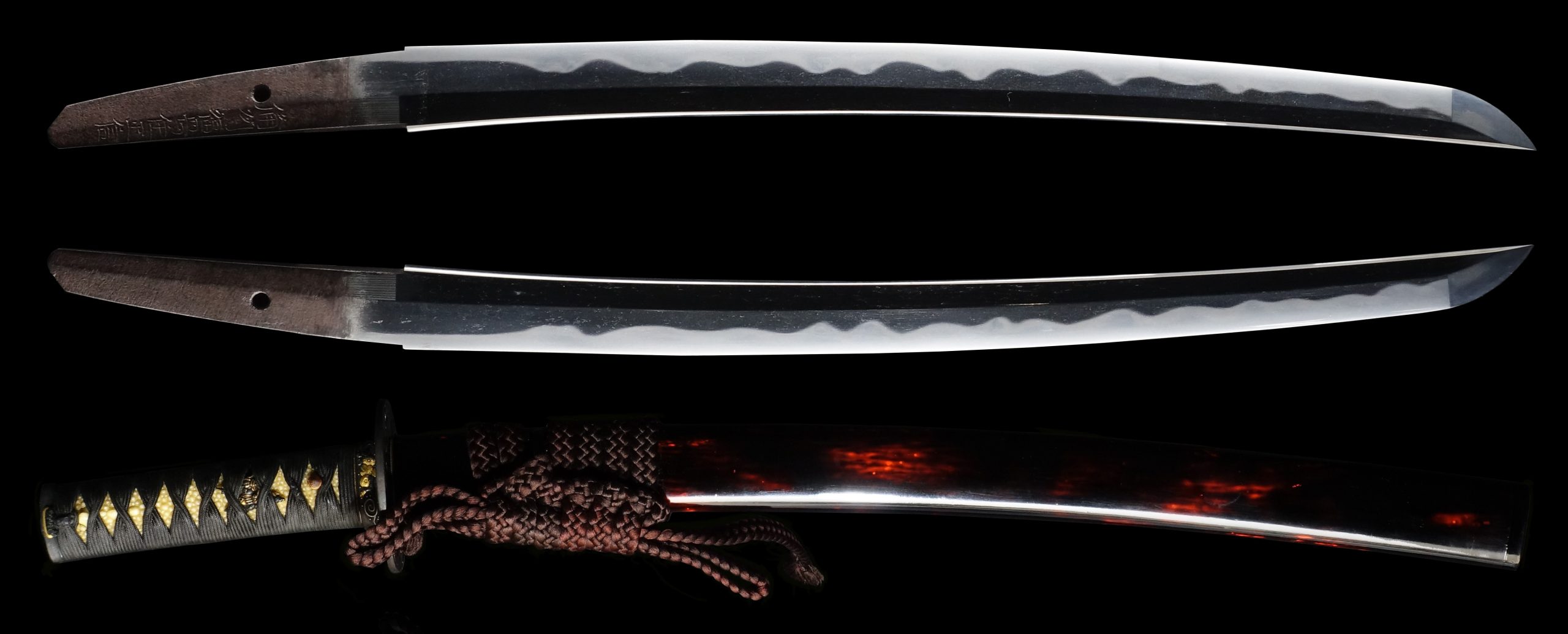
Hamon:
The crystalline structure which forms along the cutting edge of a blade as a result of the hardening process
Jimon(Jihada):
visible steel surface pattern created by folding and hammering during forging process
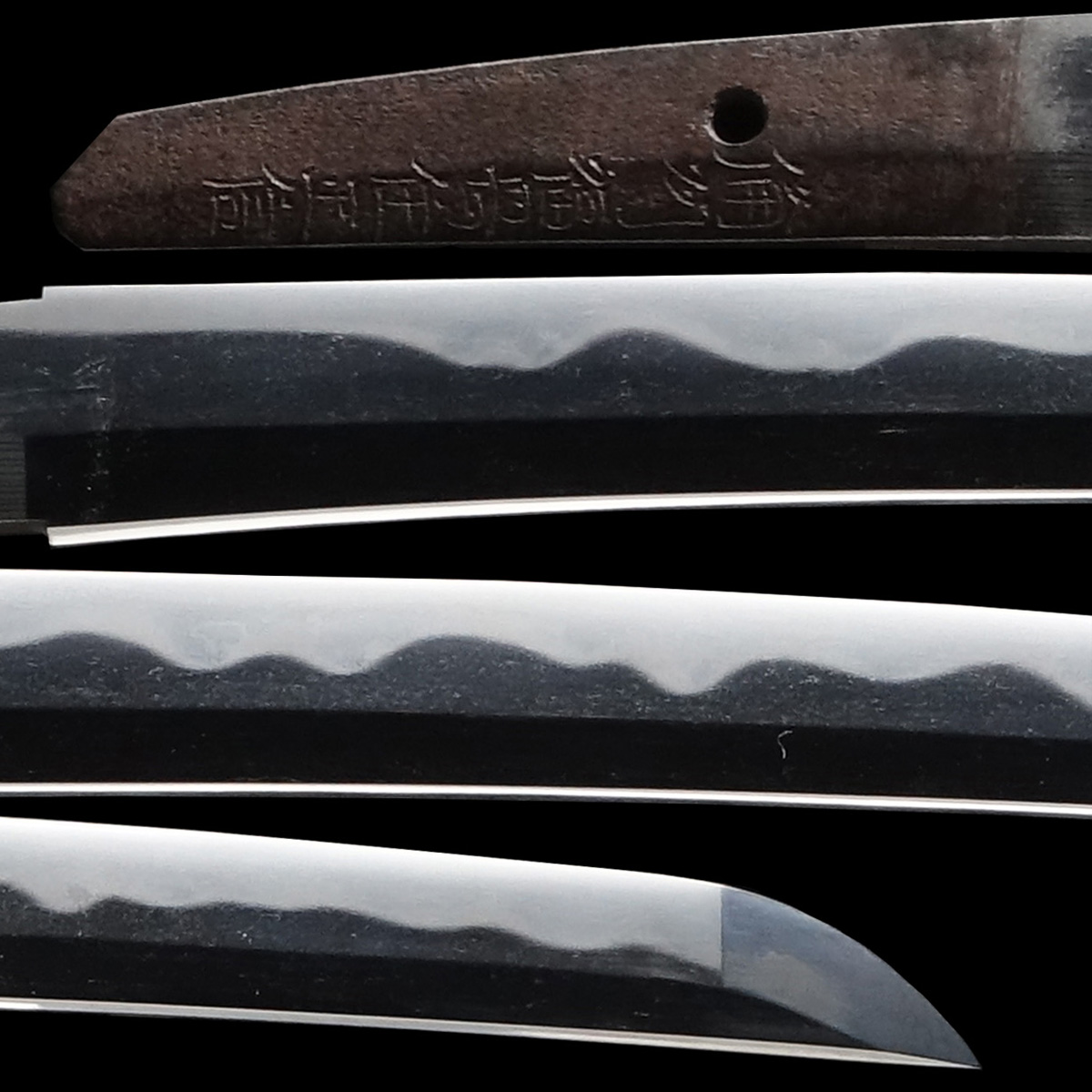
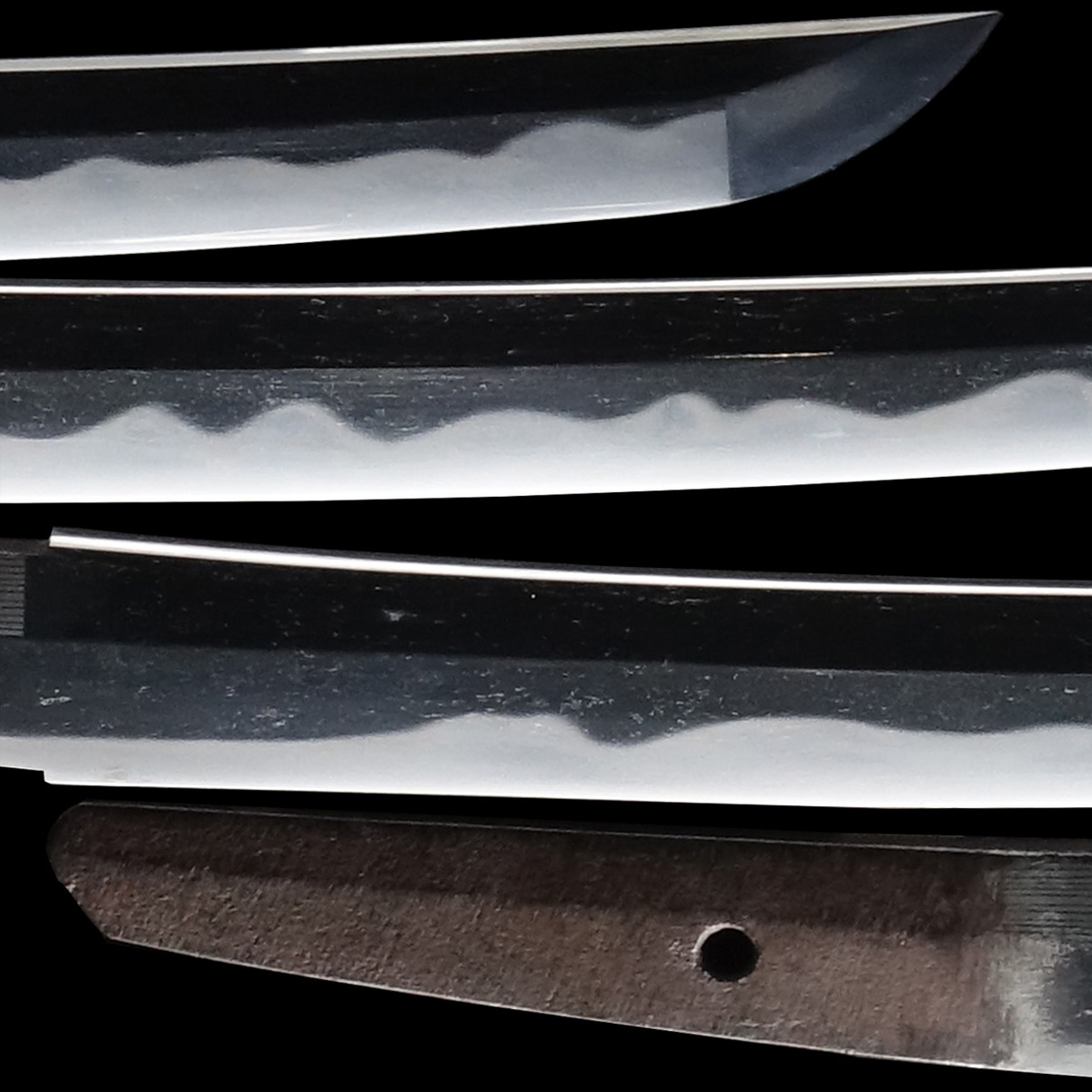

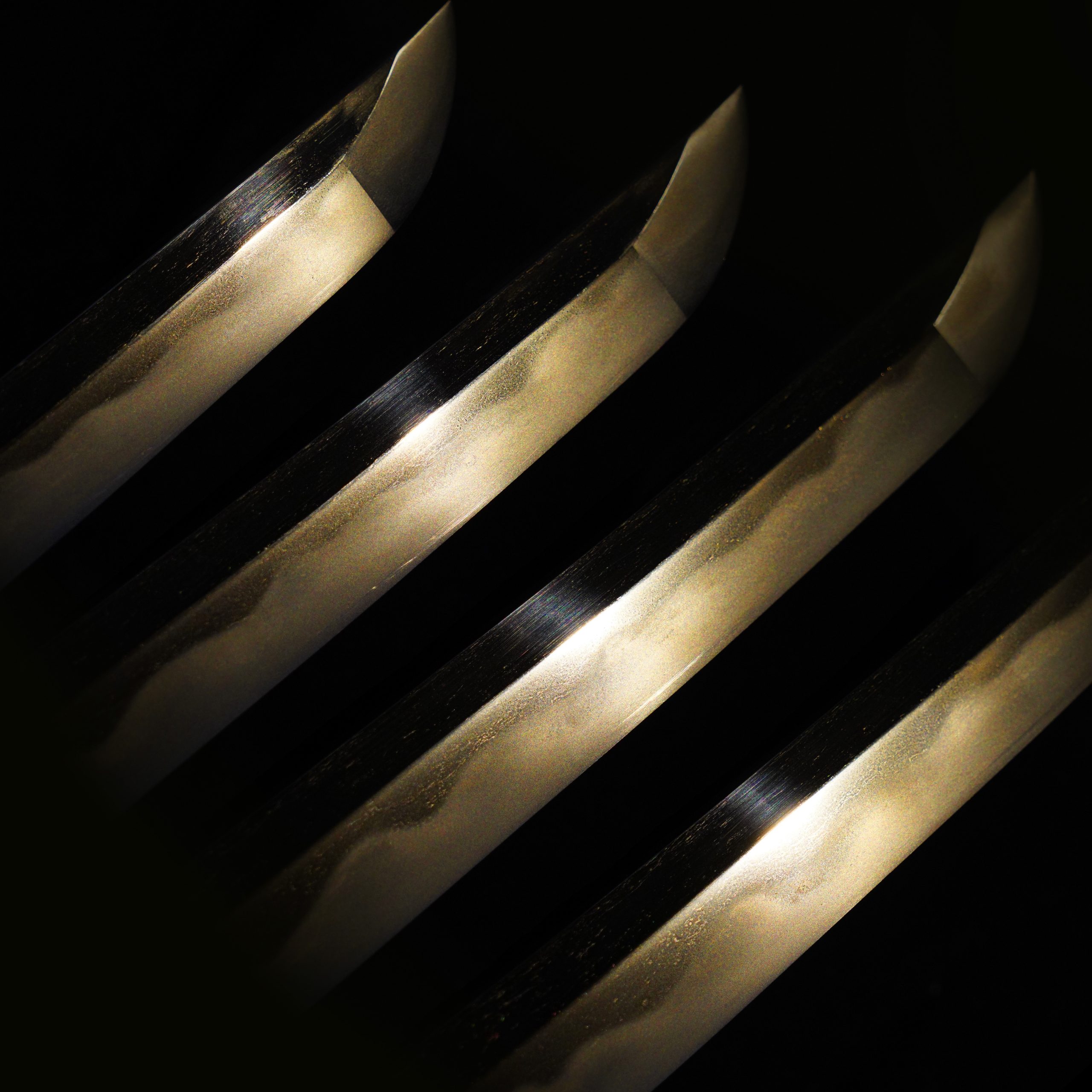
Nakago:Nakago is the tang of the Japanese sword.
Japanese swordsmiths left the black rust on the tang on purpose to prevent red rust while the tang is in its handle. And the discoloration of the tang was created over time, which is a great indicator for a Japanese sword specialist to estimate when the sword was forged.
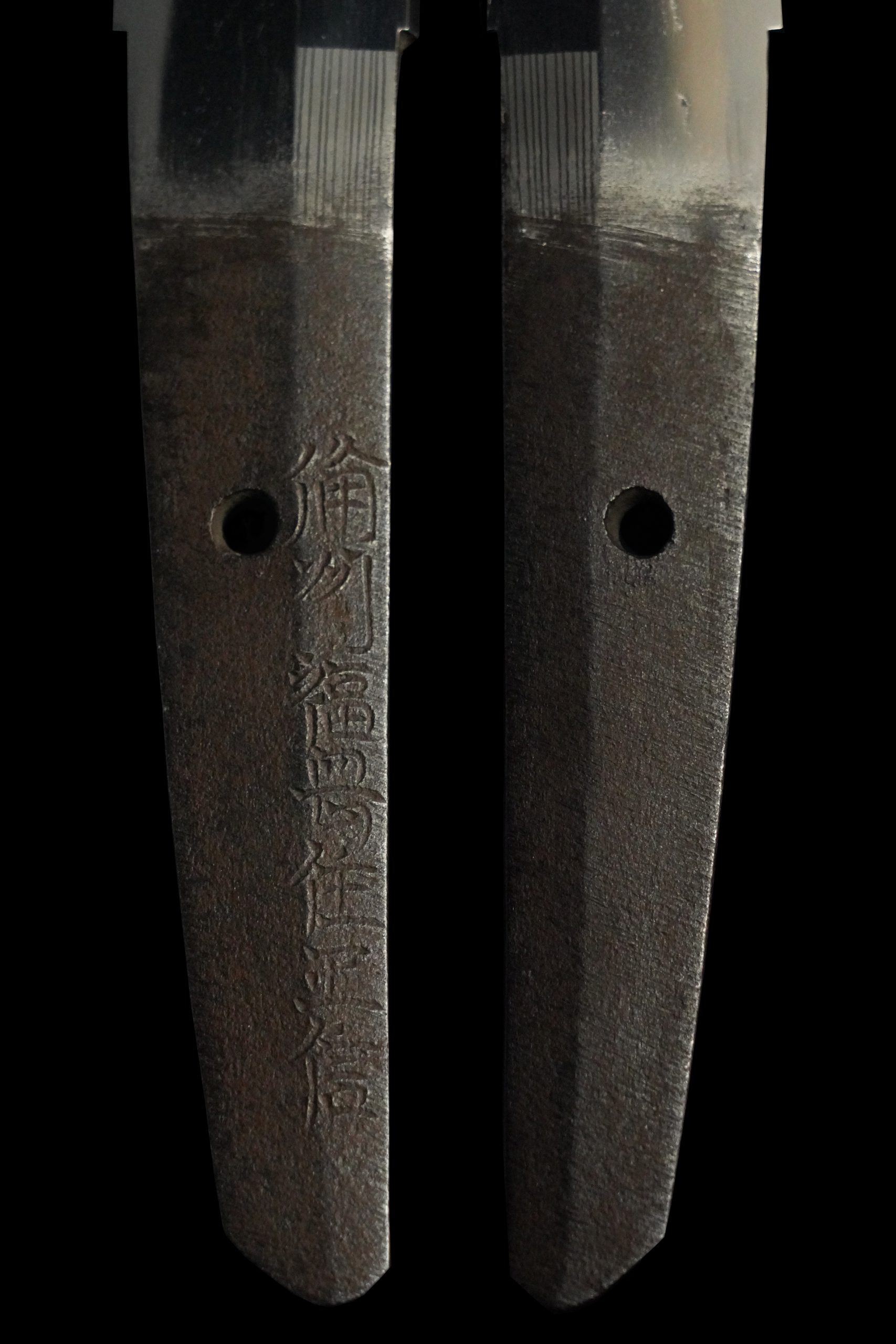
Koshirae: Koshirae is the mounting of the Japanese sword. There are several parts that consist of Koshirae such as Saya(Scabbard), Tsuka( Handle), Tsuba(Handguard).

Fuchi-Kashira:A pair of matching sword fittings that cover the upper and bottom parts of its sword hilt.
Chrysanthemum flowers floating in running water. This design is called Kikusui (菊水, chrysanthemum, and water) in Japanese. There is also a pattern in which half of the chrysanthemum flowers are hidden in the water. Since a long time ago, the Kikusui pattern has been known as a design representing longevity based on a Chinese legend. It says we could extend our lifespan by drinking water flowing from the chrysanthemum colony. Therefore, people treated this design as a kind of good luck motif.
It is said this pattern started to be used in the Kamakura period (1185-1333). Some families used it for their family crests. Kusunoki Masashige (楠木 正成, 1294?-1336) is one of them. He contributed to the defeat of the Kamakura Shogunate and was given the chrysanthemum flower crest by Emperor Go-Daigo (後醍醐天皇, 1288-1339) in recognition of his remarkable achievements. However, Masashige chose to use the Kikusui pattern; the water flowing in the lower half of the chrysanthemum flower. A theory says it was because he thought it was too presumptuous to have the same crest as the Emperor.
The Kikusui pattern was often found in Noh (能, classical Japanese dance-drama) costumes and Kosode (小袖, a type of traditional Japanese cloth), and was called in refined names such as Nagare-Giku (流れ菊) or Kiku-no Yarimizu (菊の遣り水).

Tsuka and Menuki:Tsuka is the handle of the Japanese sword and Menuki is its decoration.
Fighting Samurais are designed for this Menuki. As they wear gorgeous armors, they are possibly high-ranked soldiers. One has a Naginata (薙刀, long pole-shaped weapon), and the other, his sword, is invisible. However, we could see that he wears a helmet with a crescent-shaped Maedate (前立て, front decoration). It seems they are on the battlefield and trying to defeat their enemies. The former owner of this sword might have longed for the bravery of these Samurais.
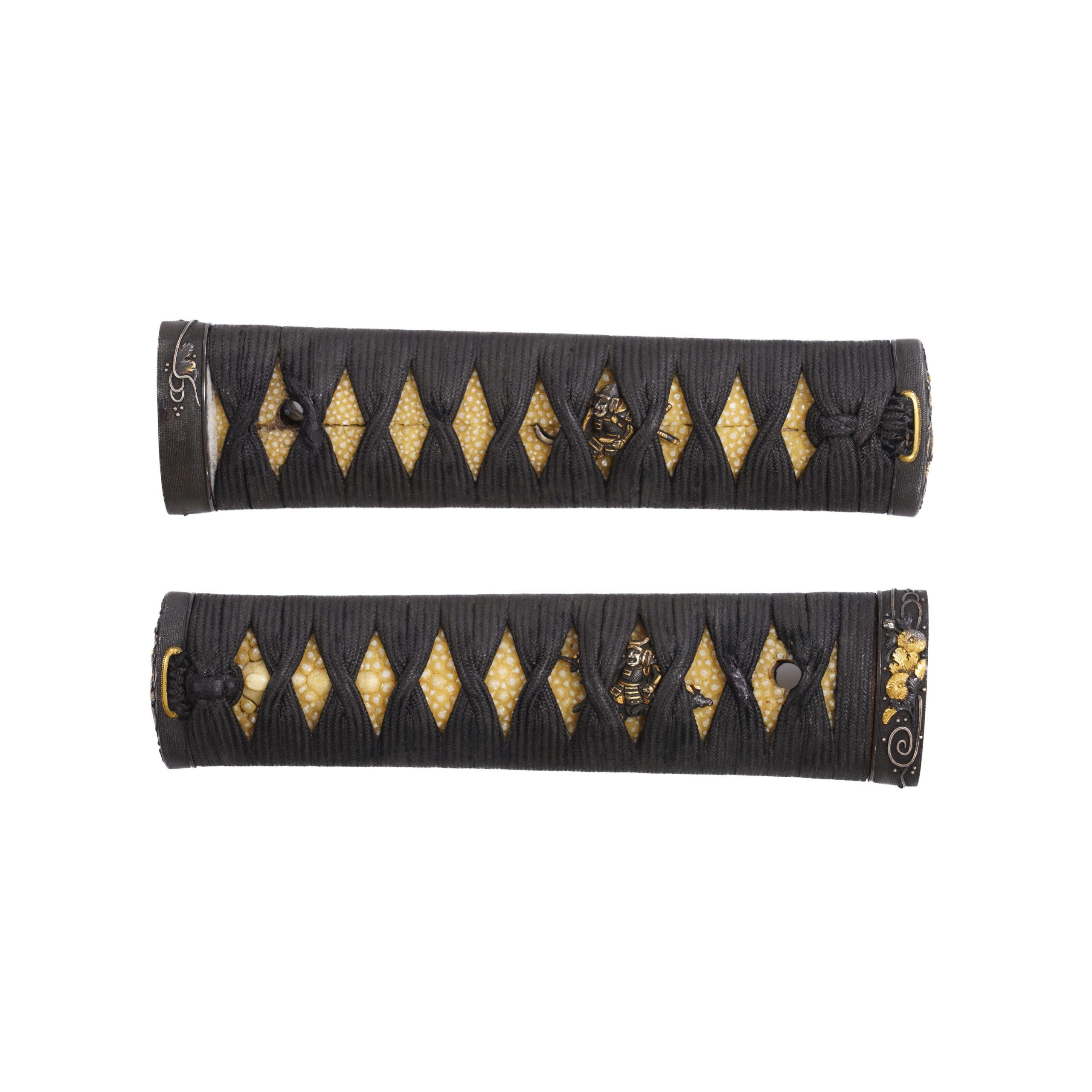
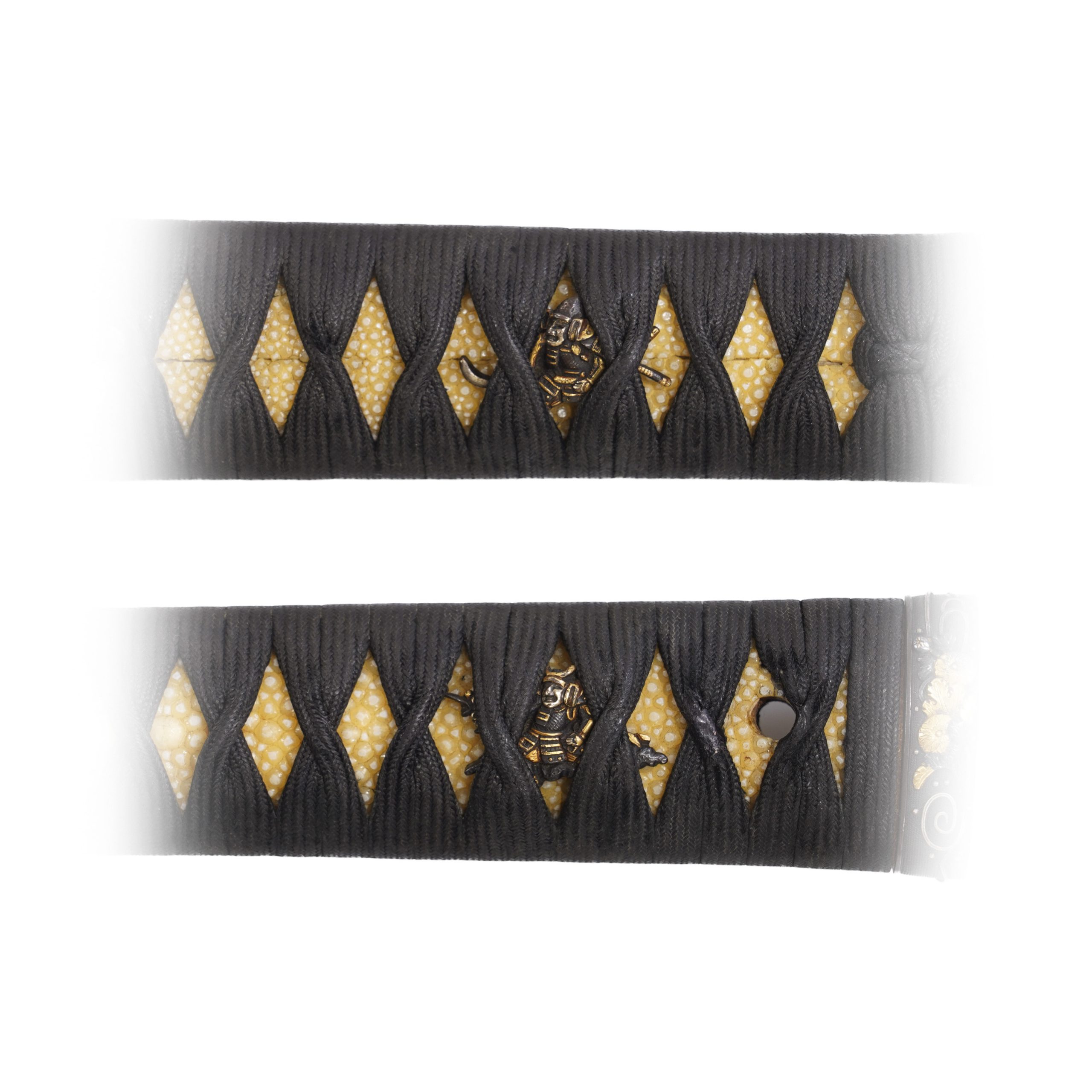
Tsuba and Habaki:Tsuba is the handguard for the Japanese Sword and Habaki is the equipment to make the blade not touch its scabbard inside. It prevents the blade from getting rusty and chipped.
Oval-shaped Tsuba made from iron. Dragons are the principal motifs of this work. It seems these dragons are looking through the clouds, or it can be seen they are floating from the surface of the water. According to a theory, a dragon dwells in the clouds. So, the combination of dragons and clouds is a famous theme. Also, there is a belief that worships dragon as a water god in Japan. Since rice cultivation has been flourished in this country, water is always an essential resource. Therefore, the combination of dragon and water could also be considered.
Initially, the dragon is an imaginary creature found in ancient traditions or myths. Furthermore, it is a symbolic beast of encouraging signs. Its body is likened to nine animals: antlers are deer, the head is a camel, eyes are demons, the neck is a snake, belly is Mizuchi (蛟, mythical animal in Japan which looks like a snake and have a horn and four legs), scales are fish, claws are falcons, palms are tigers, and ears are cows. It was thought that the dragon would reign at the top of all animals because of its odd-looking appearance.
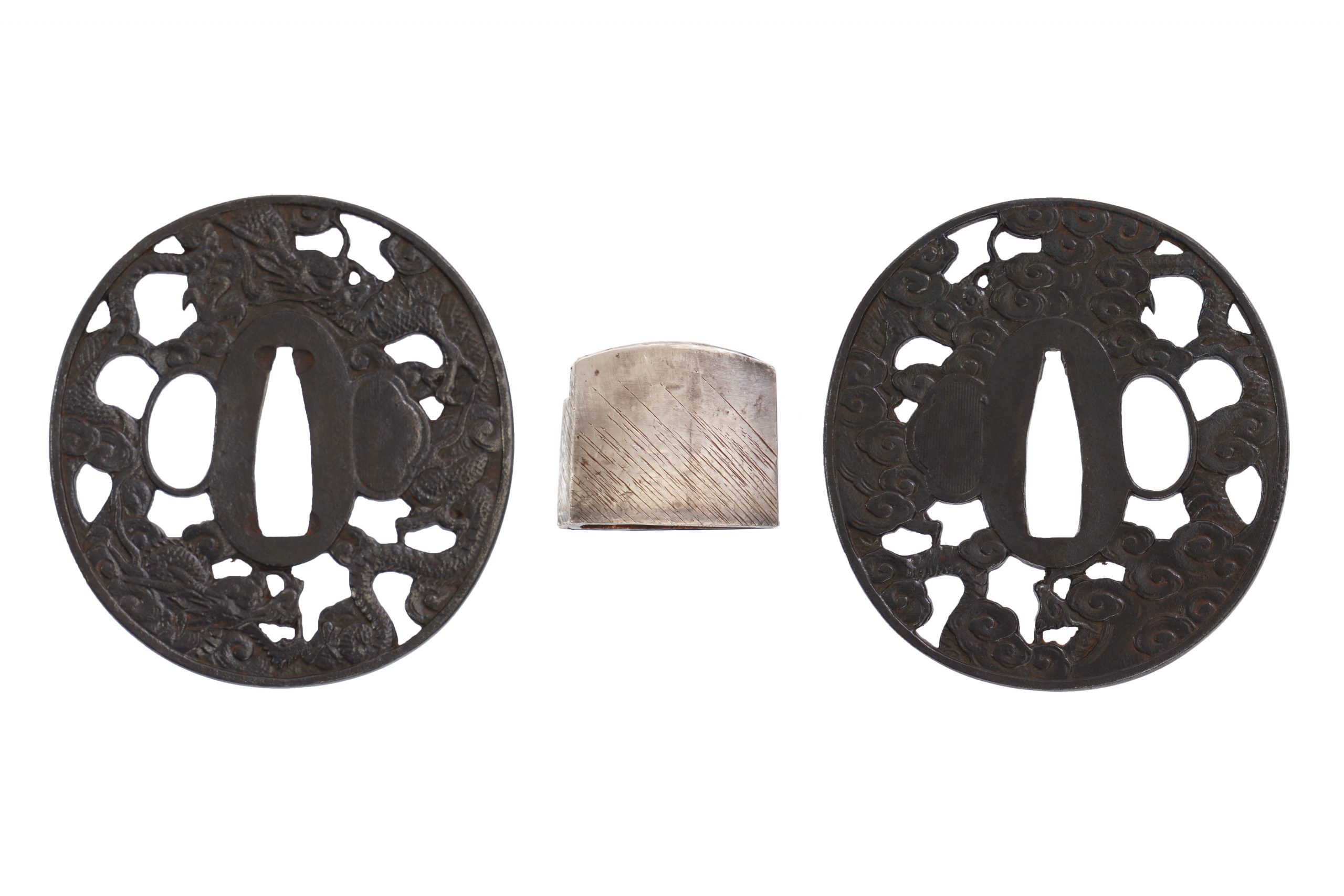
Saya: Saya is the scabbard for the Japanese sword.

Authentication Paper:NBTHK Kicho Certificate for the blade
NBTHK, also known as Nihon Bijutsu Touken Hozon Kyokai (the Society for the Preservation of the Japan Art Sword), is one of the oldest Japanese sword appraising organizations in modern-day Japan. They authenticated the blade on October 22th in the 47th year of Showa (1972). They appraised it as Kicho Touken, an old form of the authentication paper . The purchaser will receive this original certificate as well. We can also translate what is written into English and make a PDF file for your record if you request.
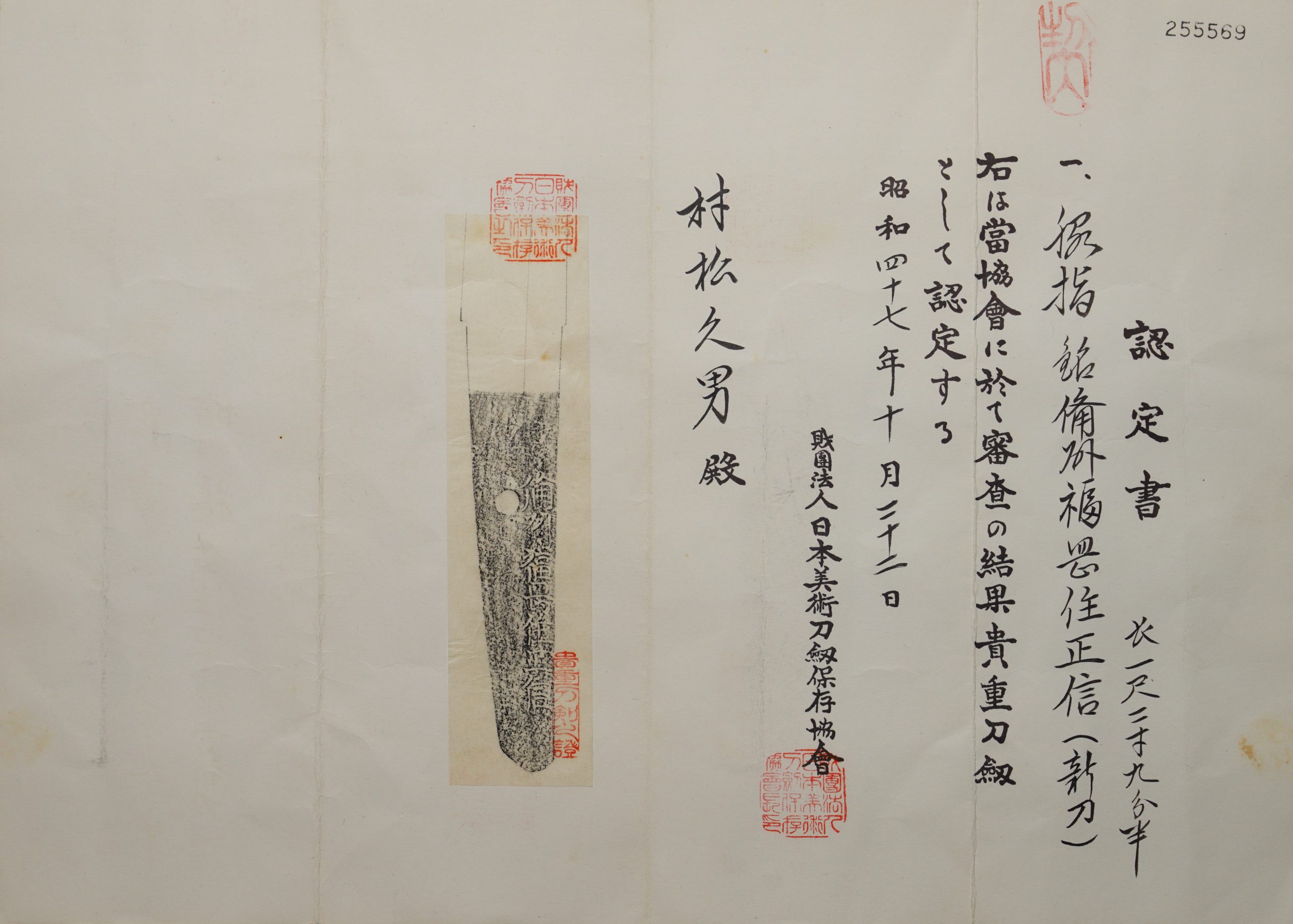
Registration Number : Tokyo 323298
The Board of Education in Tokyo prefecture issued a registration paper for this sword . In order to obtain this paper, the sword needs to be traditionally hand forged. With this paper, its owner can legally own an authentic Japanese sword in Japan. This paper will need to be returned to the board of education when the sword being shipped abroad but you can receive a copy of it.
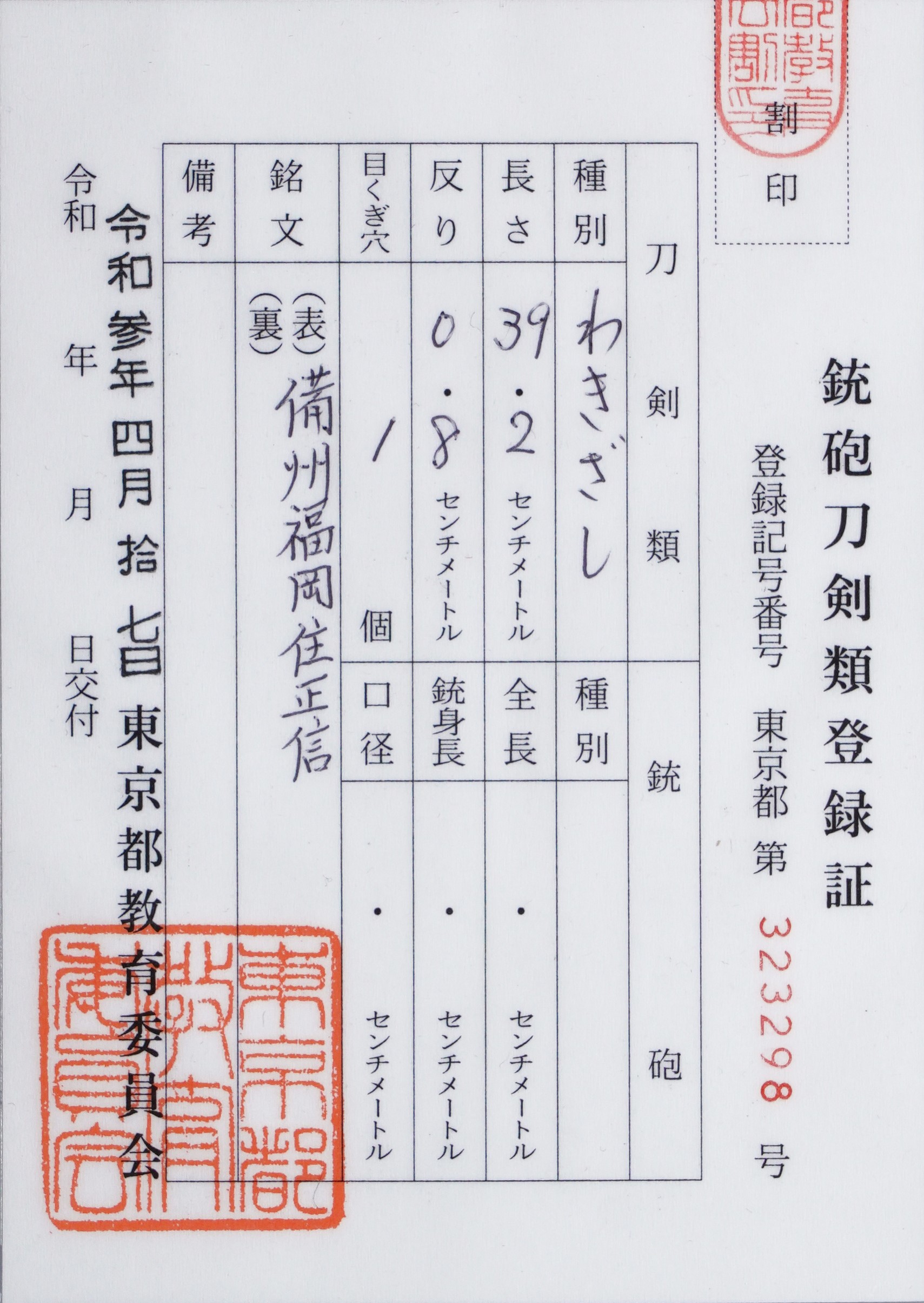
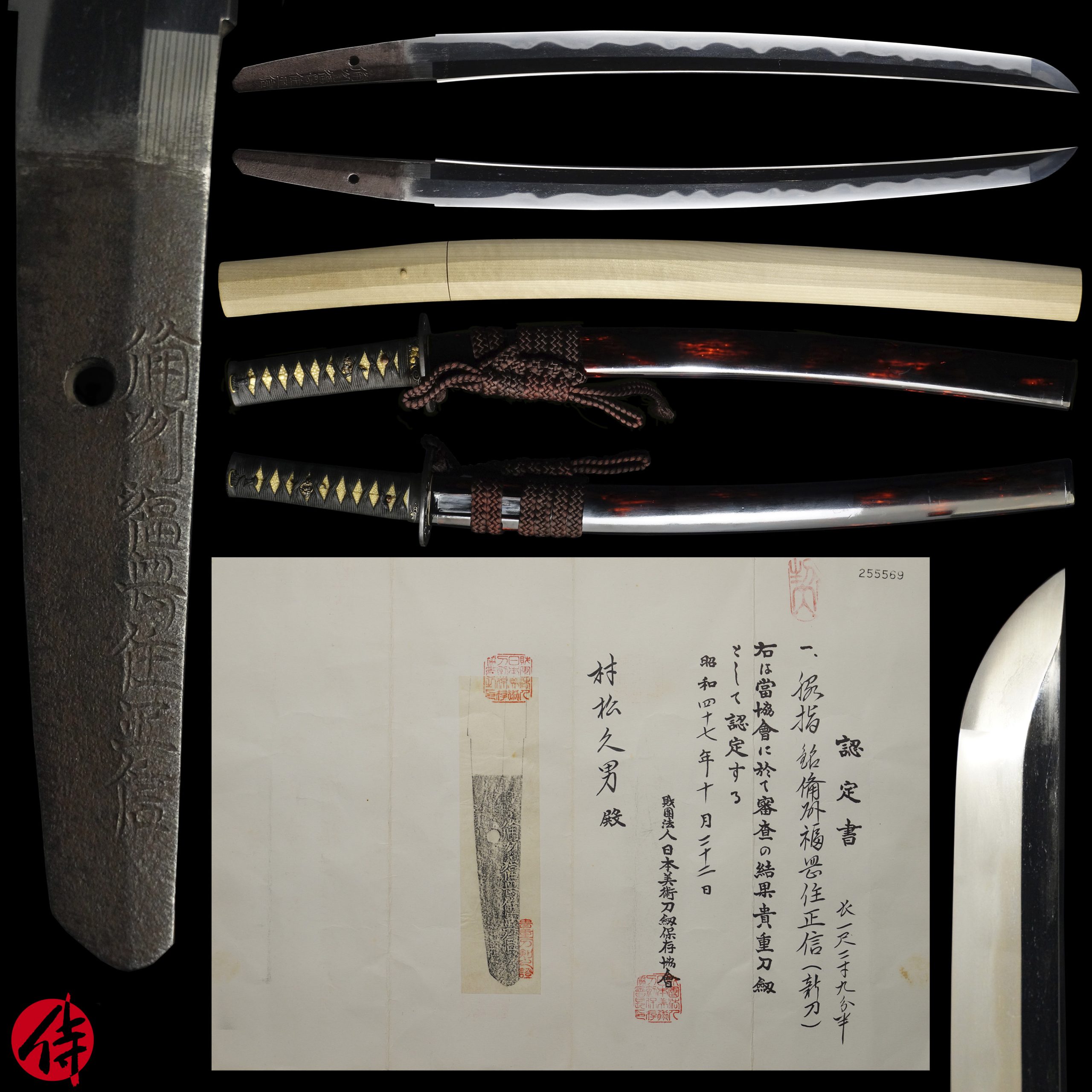
—————————————————————–
【About us】
Samurai Museum is located in Tokyo, Japan, exhibiting antique artifacts related to the Samurai history. Samurai Museum Shop is the place for those who are interested in Japanese culture and craftsmanship. We deal with antique Samurai swords/armor, traditional crafts made in Japan and so on.
【Japanese Sword& Export Process】
The Japanese swords we deal with are hand-forged edged swords made in Japan. It was made from the traditional carbon steel called TAMAHAGANE(玉鋼). Samurai Museum is familiar with the proper legal procedure for an antique/ authentic Japanese sword to be exported from Japan. We have sent more than 300 Japanese swords to amazing owners who appreciate its historical value.
Each Japanese sword is registered under the Agency for Cultural Affairs and the Board of Education in Japan.They issue a registration paper for each Japanese sword for its owner in Japan to legally possess it. The Japanese sword with its registration paper means it was traditionally hand-forged in Japan.
To legally export the sword from Japan to other countries, we will have to apply for its permit to the Agency for Cultural Affairs(Bunkacho) and return the original registration paper to the Board of Education. It normally takes around 2-4 weeks to receive this permit after submitting required documents. And we would like you to expect at least 1-1.5 months for your order to arrive at your given address after you ordered. For more detailed info, please click here.
It is allowed for residents in Japan to own authentic Japanese swords without a special license as long as they come with registration papers. Please feel free to contact us if you are a resident of Japan, whether temporarily or permanently. We will also assist you when you leave Japan and need to obtain the export permit.
【Payment Method】
We accept payment through Stripe(Credit card), PayPal, Apple Pay or ChromePay, all of which are secure payment methods. If you prefer other payment method, please contact us. After confirming your payment, we will apply for an export permit. You may either pay in JPY, USD, AUD, EUR or GBP. The price is set in Japanese Yen. Prices in other currencies are automatically calculated based on the latest exchange rate.

【Shipping】
We have shipped authentic Japanese swords to the USA, Canada, Mexico, UK, Germany , France and Hong Kong. If you don’t live in these countries and like to order, please contact us first before making a purchase. We offer Free International Shipping as long as we can send antique Japanese swords by either EMS or FedEx(Canada).
We normally ship by EMS(Express Mail Service) provided by Japan Post. When we receive an order from the Canada we will use FedEx instead as EMS temporarily stops shipping from Japan to those countries due to COVID-19.
We will send you a tracking number for your order as soon as we hand it to the post office/FedEx. We will put 100 % insurance on the shipping document without any extra charge. Based on the total amount, there might be a duty tax or other fee for you to pay, depending on the countries. We use package cushioning to protect the item and put it in a PVC pipe, which is one of the most secure packages because of its durability.
It will normally takes 5-14 days for the item to arrive at your given address after we dispatch it. Time of delivery is estimated as accurately as possible by the carrier but does not take into account any delays beyond our control such as by inclement weather, post office holiday seasons.
*Please keep in mind that due to the spread of COVID-19, there might be delays in shipping. If you like to know the detail about shipping, please feel free to ask us.

【How to make sure the condition】
Please keep in mind that what you are going to purchase is an antique item. We uploaded high resolution photos for you to check its condition thoroughly. If you like to see more photos with different angles, please feel free to contact us. We will be happy to send them to you so that you can make informed decision. It is essential for us to know that you are happy with your choice of a sword. and we are prepared to use the best of our ability to serve you.
【The Art of Nihonto(Japanese Sword)】
Samurai’s history is a profound, eloquent legacy of ancient Japanese warriors in which millions of people worldwide are being fascinated. If you like to find out the art of Nihonto, please click here.
【A Guide to Japanese Sword Maintenance】
After acquiring an genuine Japanese sword, it is also important to know how to take good care of it. Here is the special video for you. Mr. Paul Martin, Japanese sword expert, shows you how to give proper maintenance to your sword. When you purchase a Japanese sword from us, you can get a Free sword maintenance kit, which appears in this video.

